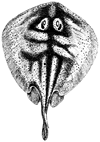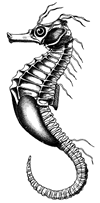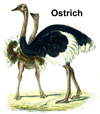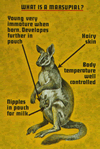The vertebrates
Within each of the five kingdoms of living things there are further groupings. These form a hierarchy of groups from the largest category (Phylum) where the groups contain the most individuals and show the most diversity, to the bottom category (species) with a small number of similar types. Carolus Linnaeus, in the late 1700's, devised a classification system based on similar structural features. Under this system humans are classified as:
| Kingdom: | Animalia |
increasing diversity more types in group
|
||
| Phylum: | Chordata (sub-phylum Vertebrata) |
|||
| Class: | Mammalia | |||
| Order: | Primates |
fewer types in group increasing similarity
|
||
| Family: | Hominidae | |||
| Genus: | Homo | |||
| Species: | sapiens |
- Class
Reptilia: Reptiles. Terrestrial and
aquatic, but all have lungs and breathe air. Dry, scaly skin, three-chambered
heart, eggs with soft shells or young born alive, e.g. tortoise, crocodile,
snakes, lizards, goannas.
- Class
Aves: Birds. Mostly terrestrial, scales modified as feathers,
hard-shell eggs, front limbs modified as wings, four-chambered heart,
endothermic (warm-blooded), e.g. kiwi, emu, all birds.
- Class
Mammalia: Mostly terrestrial, mammary glands of females produce
milk, scales modified as hairs or fur, four-chambered heart, endothermic
(warm-blooded). Mammals survive successfully in most habitats because
they are endothermic and show a wide range of adaptations.
Orders of mammals
All classes are further sub-divided into Orders. We
will investigate Class Mammalia further.
- Order Monotremata:
Egg laying mammals. Mammary glands lack nipples. There are only two
monotremes in the world, both of which are only found in Australia -
the platypus and the echidna.
- Order Marsupialia:
Pouched mammals. Young born undeveloped, then grow further on a nipple
in the pouch, e.g. kangaroo, possum.
- Order Primates:
Internal development of young with placenta, eyes usually directed forward,
nails instead of claws, e.g. monkey, chimp, ape, human.
- Other separate orders group together:
- Rats, mice, porcupines - Rodentia
- Rabbits, hares - Lagomorpha
- Dolphins, whales - Cetacea
- Tigers, dogs, cats, foxes - Carnivora
- Seals, walruses - Pinnipedia
- Elephants - Proboscidea
- Dugongs, manatees - Sirenia
- Horses, rhinoceroses - Perissodactyla
- Herbivores such as sheep, pigs, camels, deer, giraffes - Artiodactyla
- Rats, mice, porcupines - Rodentia
These groups are distinguished by different characteristics. However, the distinctions are man-made, which means that differing opinions will result in minor variations in classification systems. Not all biologists agree!
Each order is then further divided into Families, Genera (sing. Genus) and Species (sing. Species).
| Copyright owned by the State of Victoria (Department of Education and Early Childhood Development). Used with Permission. |
|
|||||||||||||||||||||||||||||||||||||||||||||||||||||||||||||||||||||||||||||||||||||













